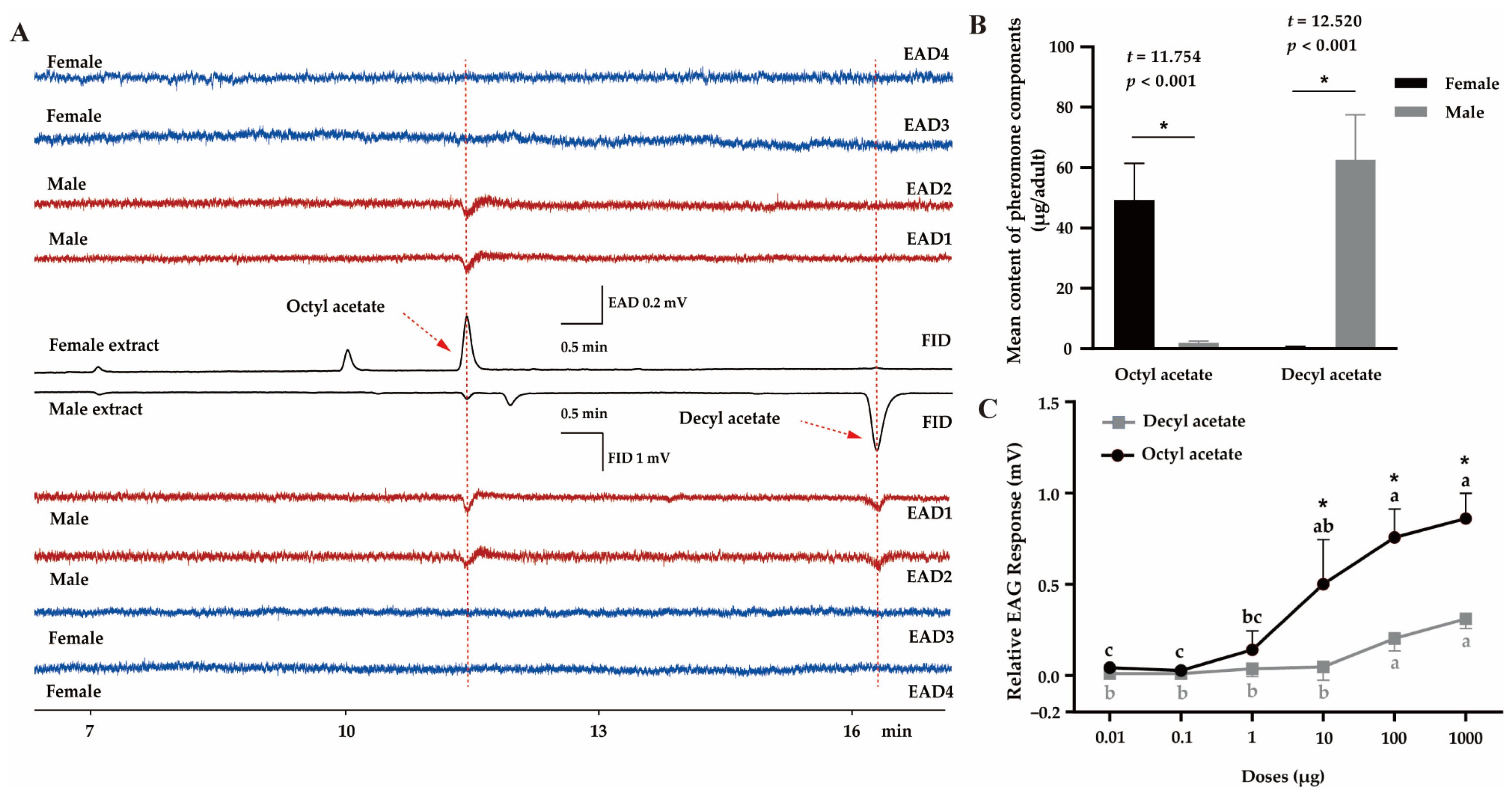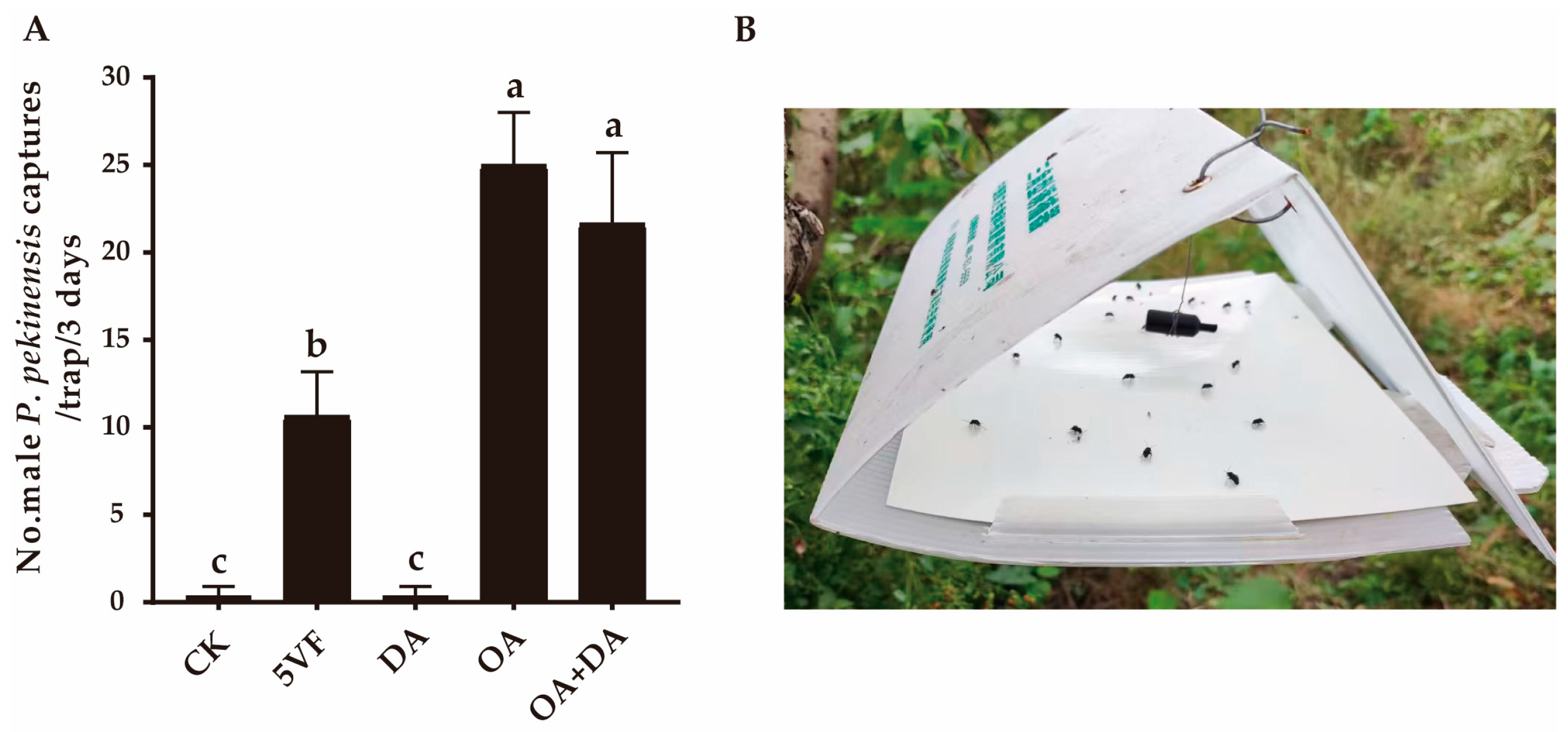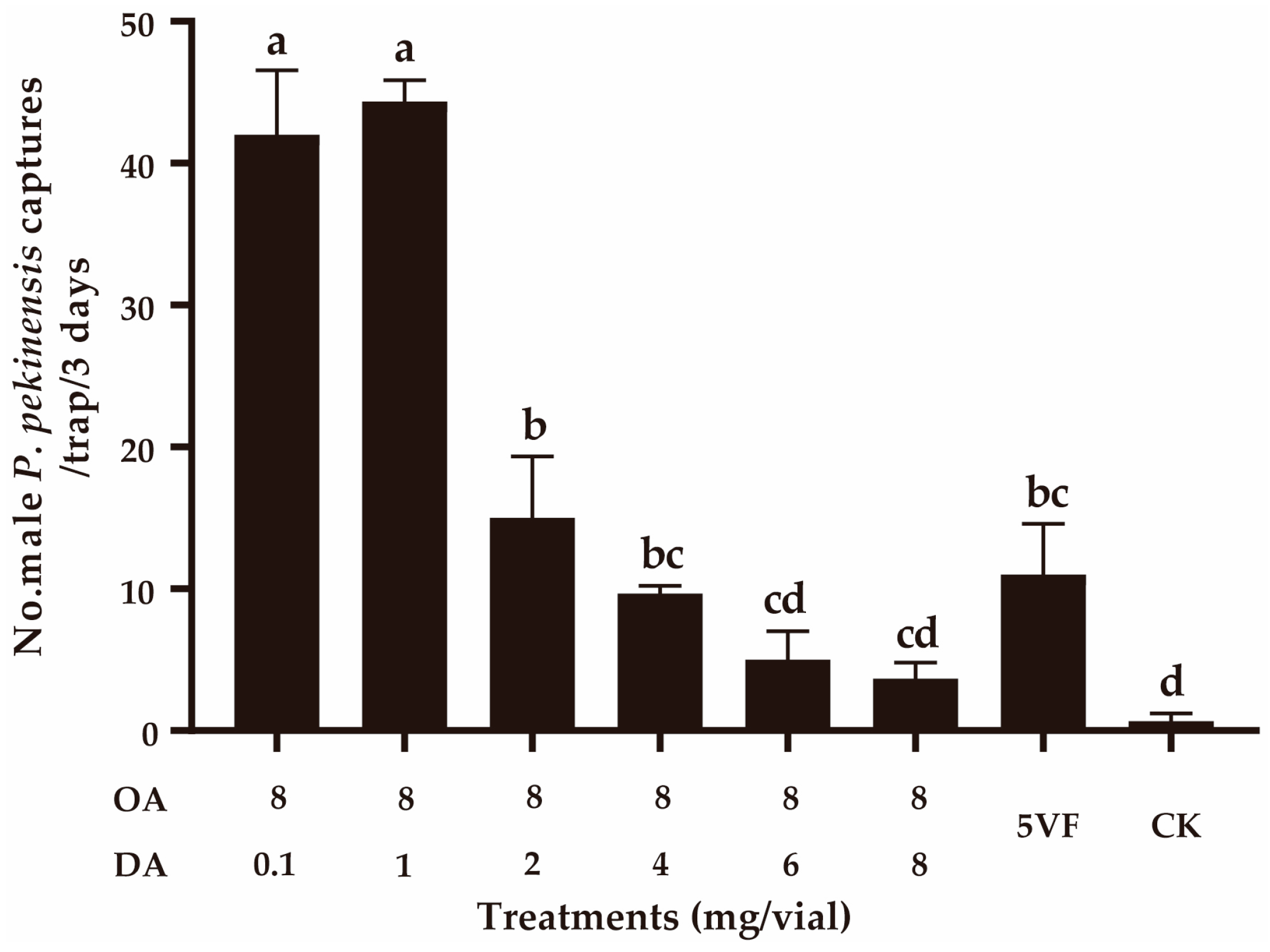Identification of Female Sex Pheromone of a Plant Bug, Polymerus pekinensis Reuter (Hemiptera: Miridae)
Simple Summary
Abstract
1. Introduction
2. Materials and Methods
2.1. Insects and Pheromone Collection
2.2. Chemicals, Lures, and Traps
2.3. GC–EAD Recording
2.4. GC–MS Analyses
2.5. Electroantennogram (EAG) Recordings
2.6. Field Trials
2.7. Statistical Analysis
3. Results
3.1. Pheromone Identification
3.2. Field Trapping
4. Discussion
5. Conclusions
Supplementary Materials
Author Contributions
Funding
Data Availability Statement
Conflicts of Interest
References
- Rizvi, S.A.H.; George, J.; Reddy, G.V.P.; Zeng, X.; Guerrero, A. Latest developments in insect sex pheromone research and its application in agricultural pest management. Insects 2021, 12, 484. [Google Scholar] [CrossRef]
- Wyatt, T.D. Pheromones. Curr. Biol. 2017, 27, R739–R743. [Google Scholar] [CrossRef] [PubMed]
- Butenandt, V.A. Uber den sexsual-lockstoff des seidenspinners Bombyx mori. Reindarstellung Und Konstitution. Z. Naturforschg B 1959, 14, 283. [Google Scholar] [CrossRef]
- Blomquist, G.J.; Vogt, R.G. Production and reception of insect pheromones. In Insect Pheromone Biochemistry and Molecular Biology; Academic Press: London, UK, 2021; pp. 1–12. [Google Scholar]
- Ando, T.; Yamamoto, M. Semiochemicals containing lepidopteran sex pheromones: Wonderland for a natural product chemist. J. Pestic. Sci. 2020, 45, 191–205. [Google Scholar] [CrossRef] [PubMed]
- Yew, J.Y.; Chung, H. Insect pheromones: An overview of function, form, and discovery. Prog. Lipid. Res. 2015, 59, 88–105. [Google Scholar] [CrossRef]
- Lu, Y.; Wyckhuys, K.A.G.; Wu, K. Pest status, bio-ecology, and area-wide management of mirids in East Asia. Annu. Rev. Entomol. 2024, 69, 393–413. [Google Scholar] [CrossRef]
- Herczek, A.; Popov, Y.A. An unusual new species of Hallodapomimus Herczek, 2000 from the Eocene Baltic amber (Hemiptera, Heteroptera, Miridae, Phylinae). Zookeys 2015, 489, 25–32. [Google Scholar] [CrossRef]
- Mnguni, S.; Peter Heshula, L.U. A Review of Chemically Based Communication in Miridae, with a Focus on Two Sympatric Species of Eccritotarsus. J. Entomol. Sci. 2023, 58, 277–293. [Google Scholar] [CrossRef]
- Zhang, T.; Mei, X.; Zhang, X.; Lu, Y.; Ning, J.; Wu, K. Identification and field evaluation of the sex pheromone of Apolygus lucorum (Hemiptera: Miridae) in China. Pest. Manag. Sci. 2020, 76, 1847–1855. [Google Scholar] [CrossRef] [PubMed]
- Zhang, T.; Zhang, X.; Wyckhuys, K.A.G.; Yao, Y.; Li, H.; Lu, W.; Lu, Y. Optimization and field demonstration of the Lygus pratensis (Hemiptera: Miridae) sex pheromone. Pest. Manag. Sci. 2021, 77, 817–823. [Google Scholar] [CrossRef]
- Mahob, R.J.; Babin, R.; ten Hoopen, G.M.; Dibog, L.; Yede; Hall, D.R.; Bilong Bilong, C.F. Field evaluation of synthetic sex pheromone traps for the cocoa mirid Sahlbergella singularis (Hemiptera: Miridae). Pest. Manag. Sci. 2011, 67, 672–676. [Google Scholar] [CrossRef] [PubMed]
- Magsi, F.H.; Cai, X.; Luo, Z.; Li, Z.; Bian, L.; Xiu, C.; Fu, N.; Li, J.; Hall, D.R.; Chen, Z. Identification, synthesis, and field evaluation of components of the female-produced sex pheromone of Helopeltis cinchonae (Hemiptera: Miridae), an emerging pest of tea. Pest. Manag. Sci. 2024, 80, 4243–4252. [Google Scholar] [CrossRef]
- Yang, C.Y.; Kim, J.; Ahn, S.; Kim, D.; Cho, M.R. Identification of the female-produced sex pheromone of the plant bug Apolygus spinolae. J. Chem. Ecol. 2014, 40, 244–249. [Google Scholar] [CrossRef] [PubMed]
- George, J.; Reddy, G.V.P.; Little, N.; Arnold, S.E.J.; Hall, D.R. Combining visual cues and pheromone blends for monitoring and management of the tarnished plant bug Lygus lineolaris (Hemiptera: Miridae). Pest. Manag. Sci. 2023, 79, 2163–2171. [Google Scholar] [CrossRef] [PubMed]
- Fountain, M.; Jåstad, G.; Hall, D.; Douglas, P.; Farman, D.; Cross, J. Further studies on sex pheromones of female lygus and related bugs: Development of effective lures and investigation of species-specificity. J. Chem. Ecol. 2014, 40, 71–83. [Google Scholar] [CrossRef] [PubMed]
- Van Tol, R.W.; Diaz Rodriguez, C.M.; de Bruin, A.; Yang, D.; Taparia, T.; Griepink, F.C. Visual attraction of the European tarnished plant bug Lygus rugulipennis (Hemiptera: Miridae) to a water trap with LED light in chrysanthemum greenhouses and olfactory attraction to novel compounds in Y-tube tests. Pest. Manag. Sci. 2022, 78, 2523–2533. [Google Scholar] [CrossRef] [PubMed]
- Zhang, Z.; Luo, J.; Wang, Y.; Chen, L.; Chen, L.; Lei, C. Morphology and chemical analysis of the metathoracic scent glands system in Adelphocoris suturalis (Hemiptera: Miridae). J. Insect Sci. 2014, 14, 293. [Google Scholar] [CrossRef] [PubMed]
- Zhang, Q.; Aldrich, J.R. Sex pheromone of the plant bug, Phytocoris calli Knight. J. Chem. Ecol. 2008, 34, 719–724. [Google Scholar] [CrossRef]
- Yang, C.Y.; Kim, S.; Kim, J.; Kang, T.; Ahn, S. Sex pheromones and reproductive isolation in five mirid species. PLoS ONE 2015, 10, e0127051. [Google Scholar] [CrossRef][Green Version]
- Leyi, Z. Fauna Sinica; Science Press: Beijing, China, 2004; Volume 113, p. 656. [Google Scholar]
- Qin, D. Investigation of Insect Pests of Lucern and Their Natural Enemies in Kangbao County of Hebei Province. Master’s Thesis, Huazhong Agricultural University, Wuhan, China, 2015. [Google Scholar]
- Araújo, M.F.; Castanheira, E.M.S.; Sousa, S.F. The buzz on insecticides: A review of uses, molecular structures, targets, adverse effects, and alternatives. Molecules 2023, 28, 3641. [Google Scholar] [CrossRef] [PubMed]
- Lu, Y.; Wyckhuys, K.A.G.; Yang, L.; Liu, B.; Zeng, J.; Jiang, Y.; Desneux, N.; Zhang, W.; Wu, K. Bt cotton area contraction drives regional pest resurgence, crop loss, and pesticide use. Plant Biotechnol. J. 2022, 20, 390–398. [Google Scholar] [CrossRef] [PubMed]
- Wang, L.; He, L.; Zhu, X.; Zhang, J.; Li, N.; Fan, J.; Li, H.; Sun, X.; Zhang, L.; Lin, Y.; et al. Large-area field application confirms the effectiveness of toxicant-infused bait for managing (Hübner) in maize fields. Pest. Manag. Sci. 2023, 79, 5405–5417. [Google Scholar] [CrossRef]
- Fountain, M.T.; Deakin, G.; Farman, D.; Hall, D.; Jay, C.; Shaw, B.; Walker, A. An effective ‘push–pull’ control strategy for European tarnished plant bug, Lygus rugulipennis (Heteroptera: Miridae), in strawberry using synthetic semiochemicals. Pest. Manag. Sci. 2021, 77, 2747–2755. [Google Scholar] [CrossRef] [PubMed]
- Wang, L.; Yang, C.; Guo, B.; She, D.; Mei, X.; Yang, X.; Ning, J. Research progress and application prospects on insect sex pheromone. Chin. J. Pestic. Sci. 2022, 24, 997–1016. [Google Scholar] [CrossRef]
- Zhang, T.; Zhang, X.; Mei, X.; Li, Y.; Gao, Z.; Ning, J. Sex pheromone of the jumping plant bug, Halticus minutus Reuter (Hemiptera: Miridae). J. Asia-Pac. Entomol. 2017, 20, 319–323. [Google Scholar] [CrossRef]
- Noge, K.; Prudic, K.L.; Becerra, J.X. Defensive Roles of (E)-2-Alkenals and Related Compounds in Heteroptera. J. Chem. Ecol. 2012, 38, 1050–1056. [Google Scholar] [CrossRef]
- Xu, H.; Zhao, J.; Li, F.; Yan, Q.; Meng, L.; Li, B. Chemical polymorphism regulates the attractiveness to nymphs in the bean bug Riptortus pedestris. J. Pest. Sci. 2021, 94, 463–472. [Google Scholar] [CrossRef]
- Mcbrien, H.; Millar, J. Pheromones of Non-Lepidopteran Insects Associated with Agricultural Plants; CABI Publishers: Wallingford, UK, 1999. [Google Scholar]
- Millar, J.G.; Rice, R.E.; Wang, Q. Sex pheromone of the mirid bug Phytocoris relativus. J. Chem. Ecol. 1997, 23, 1743–1754. [Google Scholar] [CrossRef]
- Wang, Z.; Tan, K. Honey Bee Alarm Pheromone mediates communication in plant–pollinator–predator interactions. Insects 2019, 10, 366. [Google Scholar] [CrossRef] [PubMed]
- Pérez-Hedo, M.; Rambla, J.L.; Granell, A.; Urbaneja, A. Biological activity and specificity of Miridae-induced plant volatiles. BioControl 2018, 63, 203–213. [Google Scholar] [CrossRef]
- Zheng, S.; Cai, J.; Huang, P.; Wang, Y.; Yang, Z.; Yu, Y. Determination of volatile profiles of woodland strawberry (Fragaria vesca) during fruit maturation by HS-SPME GC–MS. J. Agric. Food Chem. 2023, 103, 7455–7468. [Google Scholar] [CrossRef] [PubMed]
- Zhang, Z.; Zhang, T.; Zhang, A.; Luo, J.; Chen, L.; Wang, M.; Ning, J.; Lei, C. Identification and field verification of sex pheromone from the mirid bug, Adelphocoris suturalis. Chemoecology 2016, 26, 25–31. [Google Scholar] [CrossRef]
- Thomas, M.L. Detection of female mating status using chemical signals and cues. Biol. Rev. 2011, 86, 1–13. [Google Scholar] [CrossRef]
- Farias, L.R.; Schimmelpfeng, P.H.C.; Togawa, R.C.; Costa, M.M.C.; Grynberg, P.; Martins, N.F.; Borges, M.; Blassioli-Moraes, M.C.; Laumann, R.A.; Báo, S.N.; et al. Transcriptome-based identification of highly similar odorant-binding proteins among neotropical stink bugs and their egg parasitoid. PLoS ONE 2015, 10, e0132286. [Google Scholar] [CrossRef] [PubMed]
- Pfeiffer, L.; Ruther, J.; Hofferberth, J.; Stökl, J. Interference of chemical defence and sexual communication can shape the evolution of chemical signals. Sci. Rep. 2018, 8, 321. [Google Scholar] [CrossRef]
- Löfstedt, C.; Wahlberg, N.; Millar, J.G. Evolutionary Patterns of Pheromone Diversity in Lepidoptera; University of California Press: Oakland, CA, USA, 2016; Volume 1, pp. 43–82. [Google Scholar] [CrossRef]
- Hall, D.R.; Serrano, J.; Yokota, G.Y.; Nieto, D.J.; Farman, D.I.; McElfresh, J.S.; Del Pozo-Valdivia, A.I.; Millar, J.G.; Daane, K.M. Development of practical pheromone lures for Lygus hesperus and Lygus elisus (Heteroptera: Miridae). J. Econ. Entomol. 2024, toae266. [Google Scholar] [CrossRef] [PubMed]
- Wang, L.; Yang, C.; Mei, X.; Guo, B.; Yang, X.; Zhang, T.; Ning, J. Identification of sex pheromone in Macdunnoughia crassisigna Warren (Lepidoptera: Noctuidae) and field optimization of the sex attractant. Pest. Manag. Sci. 2024, 80, 577–585. [Google Scholar] [CrossRef]
- Kuenen, L.P.S.; Steven McElfresh, J.; Millar, J.G. Identification of Critical Secondary Components of the Sex Pheromone of the Navel Orangeworm (Lepidoptera: Pyralidae). J. Chem. Ecol. 2010, 103, 314–330. [Google Scholar] [CrossRef] [PubMed]
- Wang, H.; Ding, B.; Dai, J.; Nazarenus, T.J.; Borges, R.; Mafra-Neto, A.; Cahoon, E.B.; Hofvander, P.; Stymne, S.; Löfstedt, C. Insect pest management with sex pheromone precursors from engineered oilseed plants. Nat. Sustain. 2022, 5, 981–990. [Google Scholar] [CrossRef]
- Zhang, S.; Yan, S.; Zhang, Z.; Cao, S.; Li, B.; Liu, Y.; Wang, G. Identification and functional characterization of sex pheromone receptors in mirid bugs (Heteroptera: Miridae). Insect Biochem. Mol. 2021, 136, 103621. [Google Scholar] [CrossRef]
- Brent, C.S.; Byers, J.A. Female attractiveness modulated by a male-derived antiaphrodisiac pheromone in a plant bug. Anim. Behav. 2011, 82, 937–943. [Google Scholar] [CrossRef]
- Zhang, Q.; Aldrich, J.R. Male-produced anti-sex pheromone in a plant bug. Naturwissenschaften 2003, 90, 505–508. [Google Scholar] [CrossRef] [PubMed]
- Sadek, M.M. Polyandry in field-collected Spodoptera littoralis moths and laboratory assessment of the effects of male mating history. Entomol. Exp. Appl. 2001, 98, 165–172. [Google Scholar] [CrossRef]




Disclaimer/Publisher’s Note: The statements, opinions and data contained in all publications are solely those of the individual author(s) and contributor(s) and not of MDPI and/or the editor(s). MDPI and/or the editor(s) disclaim responsibility for any injury to people or property resulting from any ideas, methods, instructions or products referred to in the content. |
© 2025 by the authors. Licensee MDPI, Basel, Switzerland. This article is an open access article distributed under the terms and conditions of the Creative Commons Attribution (CC BY) license (https://creativecommons.org/licenses/by/4.0/).
Share and Cite
Wang, L.; Wang, Y.; Zhang, X.; Fang, M.; Mei, X.; Zhang, T. Identification of Female Sex Pheromone of a Plant Bug, Polymerus pekinensis Reuter (Hemiptera: Miridae). Insects 2025, 16, 111. https://doi.org/10.3390/insects16020111
Wang L, Wang Y, Zhang X, Fang M, Mei X, Zhang T. Identification of Female Sex Pheromone of a Plant Bug, Polymerus pekinensis Reuter (Hemiptera: Miridae). Insects. 2025; 16(2):111. https://doi.org/10.3390/insects16020111
Chicago/Turabian StyleWang, Liuyang, Yubo Wang, Xiaofang Zhang, Meijuan Fang, Xiangdong Mei, and Tao Zhang. 2025. "Identification of Female Sex Pheromone of a Plant Bug, Polymerus pekinensis Reuter (Hemiptera: Miridae)" Insects 16, no. 2: 111. https://doi.org/10.3390/insects16020111
APA StyleWang, L., Wang, Y., Zhang, X., Fang, M., Mei, X., & Zhang, T. (2025). Identification of Female Sex Pheromone of a Plant Bug, Polymerus pekinensis Reuter (Hemiptera: Miridae). Insects, 16(2), 111. https://doi.org/10.3390/insects16020111







